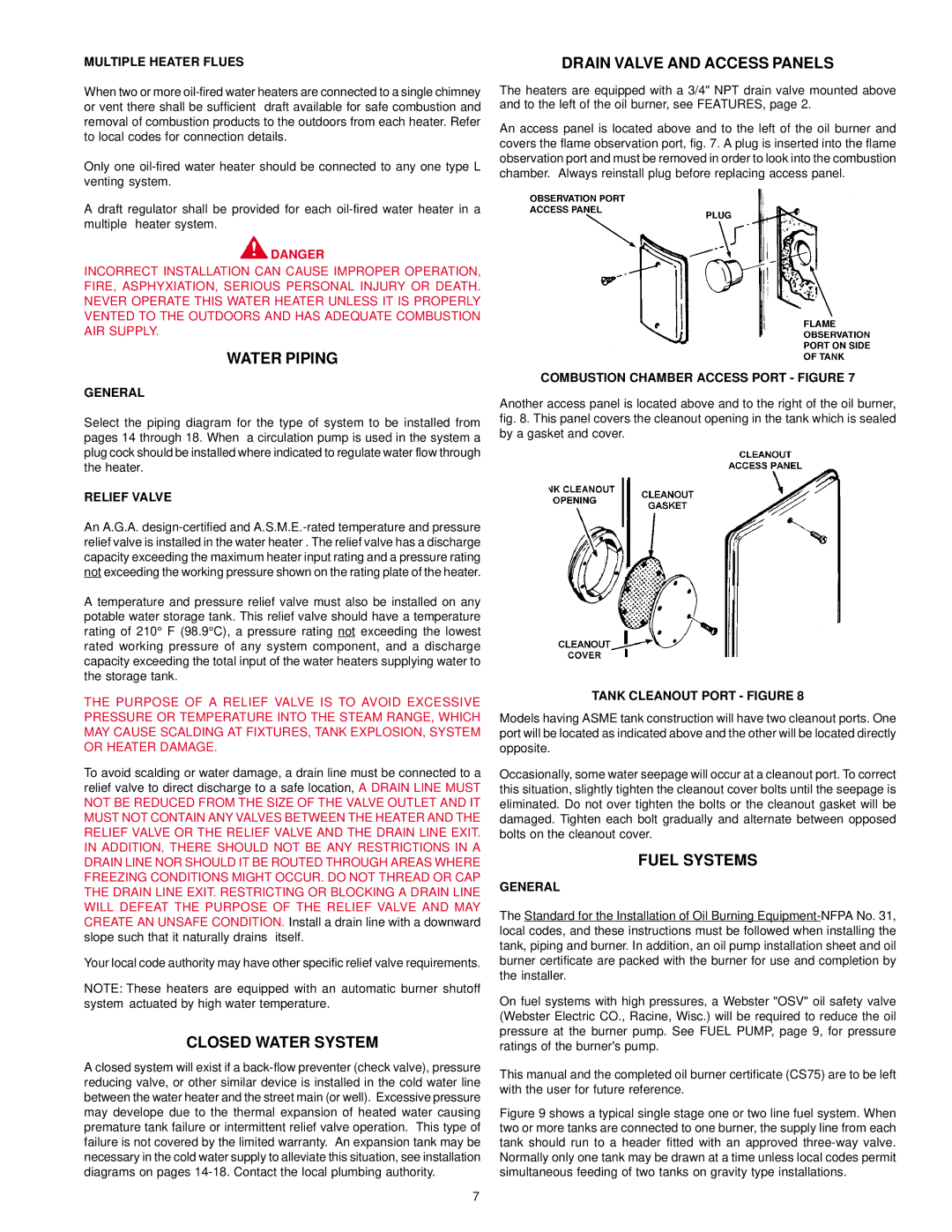
MULTIPLE HEATER FLUES | DRAIN VALVE AND ACCESS PANELS |
When two or more
Only one
A draft regulator shall be provided for each
![]() DANGER
DANGER
INCORRECT INSTALLATION CAN CAUSE IMPROPER OPERATION, FIRE, ASPHYXIATION, SERIOUS PERSONAL INJURY OR DEATH. NEVER OPERATE THIS WATER HEATER UNLESS IT IS PROPERLY VENTED TO THE OUTDOORS AND HAS ADEQUATE COMBUSTION AIR SUPPLY.
WATER PIPING
GENERAL
Select the piping diagram for the type of system to be installed from pages 14 through 18. When a circulation pump is used in the system a plug cock should be installed where indicated to regulate water flow through the heater.
RELIEF VALVE
An A.G.A.
A temperature and pressure relief valve must also be installed on any potable water storage tank. This relief valve should have a temperature rating of 210° F (98.9°C), a pressure rating not exceeding the lowest rated working pressure of any system component, and a discharge capacity exceeding the total input of the water heaters supplying water to the storage tank.
THE PURPOSE OF A RELIEF VALVE IS TO AVOID EXCESSIVE PRESSURE OR TEMPERATURE INTO THE STEAM RANGE, WHICH MAY CAUSE SCALDING AT FIXTURES, TANK EXPLOSION, SYSTEM OR HEATER DAMAGE.
To avoid scalding or water damage, a drain line must be connected to a relief valve to direct discharge to a safe location, A DRAIN LINE MUST NOT BE REDUCED FROM THE SIZE OF THE VALVE OUTLET AND IT MUST NOT CONTAIN ANY VALVES BETWEEN THE HEATER AND THE RELIEF VALVE OR THE RELIEF VALVE AND THE DRAIN LINE EXIT. IN ADDITION, THERE SHOULD NOT BE ANY RESTRICTIONS IN A DRAIN LINE NOR SHOULD IT BE ROUTED THROUGH AREAS WHERE FREEZING CONDITIONS MIGHT OCCUR. DO NOT THREAD OR CAP THE DRAIN LINE EXIT. RESTRICTING OR BLOCKING A DRAIN LINE WILL DEFEAT THE PURPOSE OF THE RELIEF VALVE AND MAY CREATE AN UNSAFE CONDITION. Install a drain line with a downward slope such that it naturally drains itself.
Your local code authority may have other specific relief valve requirements.
NOTE: These heaters are equipped with an automatic burner shutoff system actuated by high water temperature.
CLOSED WATER SYSTEM
A closed system will exist if a
The heaters are equipped with a 3/4" NPT drain valve mounted above and to the left of the oil burner, see FEATURES, page 2.
An access panel is located above and to the left of the oil burner and covers the flame observation port, fig. 7. A plug is inserted into the flame observation port and must be removed in order to look into the combustion chamber. Always reinstall plug before replacing access panel.
COMBUSTION CHAMBER ACCESS PORT - FIGURE 7
Another access panel is located above and to the right of the oil burner, fig. 8. This panel covers the cleanout opening in the tank which is sealed by a gasket and cover.
TANK CLEANOUT PORT - FIGURE 8
Models having ASME tank construction will have two cleanout ports. One port will be located as indicated above and the other will be located directly opposite.
Occasionally, some water seepage will occur at a cleanout port. To correct this situation, slightly tighten the cleanout cover bolts until the seepage is eliminated. Do not over tighten the bolts or the cleanout gasket will be damaged. Tighten each bolt gradually and alternate between opposed bolts on the cleanout cover.
FUEL SYSTEMS
GENERAL
The Standard for the Installation of Oil Burning
On fuel systems with high pressures, a Webster "OSV" oil safety valve (Webster Electric CO., Racine, Wisc.) will be required to reduce the oil pressure at the burner pump. See FUEL PUMP, page 9, for pressure ratings of the burner's pump.
This manual and the completed oil burner certificate (CS75) are to be left with the user for future reference.
Figure 9 shows a typical single stage one or two line fuel system. When two or more tanks are connected to one burner, the supply line from each tank should run to a header fitted with an approved three-way valve. Normally only one tank may be drawn at a time unless local codes permit simultaneous feeding of two tanks on gravity type installations.
7
